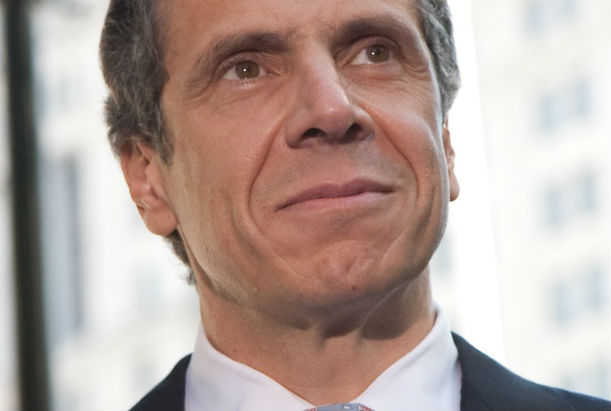 Governor Andrew M. Cuomo, Senate Majority Leader John Flanagan, Senate Independent Democratic Conference Leader Jeffrey Klein, and Assembly Speaker Carl Heastie today announced an agreement on the 2016-17 state budget. The budget holds the growth in state spending to two percent for the sixth consecutive year, continuing to reverse a decades-long trend where state spending outpaced the rate of inflation or personal incomes.
Governor Andrew M. Cuomo, Senate Majority Leader John Flanagan, Senate Independent Democratic Conference Leader Jeffrey Klein, and Assembly Speaker Carl Heastie today announced an agreement on the 2016-17 state budget. The budget holds the growth in state spending to two percent for the sixth consecutive year, continuing to reverse a decades-long trend where state spending outpaced the rate of inflation or personal incomes.
The budget also includes a number of landmark policies that will strengthen opportunity for working and middle class families and a record $24.8 billion in education aid. The budget will also grow the economy with a $4.2 billion middle class tax cut when fully effective and critical statewide infrastructure investments – including a new $55 billion State Transportation Plan that commits $27.14 billion for Department of Transportation and Thruway programs and $27.98 billion for the Metropolitan Transportation Authority.
Spending
The budget agreement includes spending in the following categories:
- Total State Operating Funds: $96.2 billion; 2.0 percent growth
- School Aid: $24.8 billion; 6.5 percent growth
- Medicaid: $18.5 billion; 3.4 percent growth under the cap
- Higher Education: $7.2 billion; 2.0 percent growth
Statement from Governor Andrew M. Cuomo:
“In a time defined by vitriolic hyper partisanship and when people have lost faith in their government’s fundamental ability to address the critical challenges of our time – in particular, the growing income inequality in our country, New York State has once again come together to get things done. Many have proposed the big changes we sought – minimum wage, meaningful paid family leave, a balanced budget that caps spending and cuts taxes – but almost all have failed. Today, I am proud to announce that with this agreement, we have succeeded.
“After decades of out-of-control spending, we have in the last five years returned fiscal responsibility to Albany by capping government growth at two percent, cutting taxes, and investing in the successful programs that are rejuvenating our upstate economy. We’ve restored New York to a position of national leadership on issues of social justice. We’re continuing that progress this year in the fight for economic justice – so that everyone, no matter who they are or where they come from, has the chance to succeed. We believe that people who work hard should be able to earn a decent living and support a family with dignity. With a statewide $15 minimum wage and the nation’s only 12-week paid family leave program, we are going to prove that the economy can and should work for all. We’re cutting taxes for the middle class, making record investments in education with $1.4 billion in new funding, turning failing schools into community schools, and ending the GEA in New York once and for all because we believe that our tomorrows can be better than our yesterdays. At the same time we are prioritizing infrastructure and transportation to not only restore what is, but also imagine and realize what can be.
“We in New York are doing all of this by coming together – democrats and republicans – to make our state stronger, safer and fairer now and for years to come.”
Statement from Senate Majority Leader John J. Flanagan:
“This agreement brings about a sixth consecutive on-time budget, ensures state government continues to live within its means and builds on the progress we have realized in making New York more affordable for middle-class taxpayers and their families. It includes a record level of funding for our schools and complete elimination of the GEA, a top Senate Republican priority. I am pleased that we have fought for and won true parity in infrastructure funding, along with more than $1 billion in real and lasting middle-income tax cuts, property tax relief for hardworking taxpayers and seniors, and creation of a program to allow New Yorkers to care for their families. I thank our partners in government, including Governor Cuomo, Speaker Heastie and Independent Democrat Conference Leader Klein, for working together with the members of our conference to achieve consensus. We have more work to do in making New York the land of opportunity for all, but today is another big step in the right direction.”
Statement from Senate Independent Democratic Caucus Leader Jeffrey Klein:
“This truly is The Year of the Worker. A victory in the Fight for $15 and Paid Family Leave will make a tremendous difference in the lives of our workforce. New York State put together the best Paid Family Leave policy in the nation. Nobody will ever have to choose between what their heart tells them to do and what their bank account allows them to do. Our minimum wage workforce also get a raise and our middle-class households receive over $1 billion in tax relief. This is a budget that should make every New Yorker proud.”
Statement from Assembly Speaker Carl E. Heastie:
“From the very first day of this session, the Assembly Majority promised New Yorkers that we would do everything in our power to deliver a stronger minimum wage and paid family leave benefits for every worker. We are proud that the final agreement not only includes these longstanding priorities of our conference but also makes significant investments in our public education system, community schools, and struggling schools while holding the line on tuition increases at our SUNY and CUNY institutions. Critically, this budget provides funding support for affordable housing, preserves access to quality health services for millions of low-income New Yorkers, and makes important investments in anti-poverty initiatives throughout the state. This is a budget that takes the necessary steps to move our communities and our state forward. I want to thank each and every one of our committee chairs for their hard work as well as all the members of the Assembly Majority for their invaluable input and advocating for the needs of their districts. The expertise of our members has been instrumental in achieving a budget that is a win for all New Yorkers.”
Details on some of the most significant parts of the budget are as follows:
Minimum Wage
- For workers in New York City employed by large businesses (those with at least 11 employees), the minimum wage would rise to $11 at the end of 2016, then another $2 each year after, reaching $15 on 12/31/2018.
- For workers in New York City employed by small businesses (those with 10 employees or fewer), the minimum wage would rise to $10.50 by the end of 2016, then another $1.50 each year after, reaching $15 on 12/31/2019.
- For workers in Nassau, Suffolk and Westchester Counties, the minimum wage would increase to $10 at the end of 2016, then $1 each year after, reaching $15 on 12/31/2021.
- For workers in the rest of the state, the minimum wage would increase to $9.70 at the end of 2016, then another .70 each year after until reaching $12.50 on 12/31/2020 – after which will continue to increase to $15 on an indexed schedule to be set by the Director of the Division of Budget in consultation with the Department of Labor.
Further, the bill provides a safety valve to the increases. Beginning in 2019, the state DOB Director will conduct an annual analysis of the economy in each region and the effect of the minimum wage increases statewide to determine whether a temporary suspension of the scheduled increases is necessary. That analysis is submitted to the Department of Labor by the Division of Budget.
It is estimated that more than 2.3 million people will be affected by the increases in the minimum wage.
Paid Family Leave
The budget agreement includes the longest and most comprehensive paid family leave program in the nation. When fully phased- in, employees will be eligible for 12 weeks of paid family leave when caring for an infant, a family member with a serious health condition or to relieve family pressures when someone is called to active military service. Benefits will be phased-in beginning in 2018 at 50 percent of an employee’s average weekly wage, capped to 50 percent of the statewide average weekly wage, and fully implemented in 2021 at 67 percent of their average weekly wage, capped to 67 percent of the statewide average weekly wage. This program will be funded entirely through a nominal payroll deduction on employees so it costs businesses – both big and small – nothing. Employees are eligible to participate after having worked for their employer for six months.
Middle Class Tax Cut
The budget lowers Personal Income Tax rates for middle class New Yorkers. With the middle class tax cuts of 2012, rates were lowered from 6.85 percent to 6.45 percent for taxpayers in the $40,000-$150,000 income bracket, and to 6.65 percent in the $150,000-$300,000 income bracket. Under these new reforms, the rate will drop even further beginning in 2018 and will continue to drop all the way to 5.5 percent when the cuts are fully phased in.
These new lower tax rates will save middle class New Yorkers nearly $6.6 billion in just the first four years, with annual savings reaching $4.2 billion by 2025. As the new rates phase in, they will be the state’s lowest middle class tax rates in more than 70 years. When the tax cuts begin, they will benefit 4.4 million filers, growing to 6 million filers when fully phased in.
Support for Schools and Education
The budget provides $24.8 billion in School Aid, the highest amount ever, and $5.3 billion more than 2011-12. While total state spending has been held to two percent annual growth and most state agency budgets have been held essentially flat, School Aid is increasing by 6.5 percent for the 2016-17 School Year and will have increased by nearly 27 percent since 2011-12. The increases of the last five years are as follows:
- 2011-12 School Aid: $19.64 billion
- 2012-13 School Aid: $20.35 billion ($805 million increase, 4.1 percent)
- 2013-14 School Aid: $21.23 billion ($992 million increase, 4.9 percent)
- 2014-15 School Aid: $22.24 billion ($1.13 billion increase, 5.3 percent)
- 2015-16 School Aid: $23.5 billion ($1.35 billion increase, 6.1 percent)
- 2016-17 School Aid: $24.8 billion ($1.5 billion increase, 6.5 percent)
School Aid supports almost 700 school districts, and 2.8 million students in grades pre-kindergarten through 12. New York schools already spend more per pupil than any state in the nation, at an average of $19,818, almost double the national average of $10,700.
In addition to traditional School Aid, the budget maintains $340 million in annual funding for the Statewide Universal Full-Day Prekindergarten program and continues the $2 billion Smart Schools program. The Budget fully eliminates the outstanding $434 million Gap Elimination Adjustment. Foundation Aid is increased by $627 million (four percent).
Community Schools: The budget also includes $175 million in funding to transform failing schools and other high needs schools into community schools. This will help ensure that issues of poverty can be addressed with communities working together to ensure that every student is prepared, safe, healthy and ready to learn. This investment is critical to providing students early opportunities to build positive future and breaking the trend of higher crime rates among underserved youth.
Charters: The Budget increases support for charter schools statewide by an estimated $430 per pupil to allow these schools to continue to innovate, recruit high-quality teachers and staff, and provide a strong educational option for students and families. The budget makes permanent the calculation of rental aid for New York City charter schools.

nfrastructure Spending
The budget contains the largest state transportation plan ever approved, with over $55 billion of transportation investments statewide, including $27.14 billion for State Department of Transportation and Thruway programs and $27.98 billion for the Metropolitan Transportation Authority programs. The plan aligns capital programming for DOT and MTA over a 5-year period (SFY 2016-20) and includes additional commitments for priority projects and programs that extend over a sixth year.
- The $27 billion DOT capital program includes: $21.1 billion for capital improvement of highways, bridges, rail, aviation infrastructure, non-MTA transit, and DOT facilities throughout the state. This includes the launch of three new initiatives – BRIDGE NY, PAVE NY, and the Extreme Weather Infrastructure Hardening Program to further improve conditions on state and local roads and bridges, as well as provide resiliency to roadways that are particularly susceptible to weather events. It also includes $4 billion for capital investment for a sixth year, and $2 billion in Thruway Stabilization funding that will support capital improvements on the entire Thruway system and the New New York Bridge, allowing the Authority to freeze tolls on the system until at least 2020.
- The $27 billion MTA Capital Program includes: $26.6 billion for improvement of capital facilities operated by the New York City Transit Authority, Long Island Rail Road, Metro-North Railroad and MTA Bus and major initiatives including $1.5 billion for Phase II of the Second Avenue Subway. Specifically, the budget authorizes a record $8.3 billion of State support for the program.
Contact the Governor’s Press Office
Become a Harlem Insider!
By submitting this form, you are consenting to receive marketing emails from: Harlem World Magazine, 2521 1/2 west 42nd street, Los Angeles, CA, 90008, https://www.harlemworldmagazine.com. You can revoke your consent to receive emails at any time by using the SafeUnsubscribe® link, found at the bottom of every email. Emails are serviced by Constant Contact








